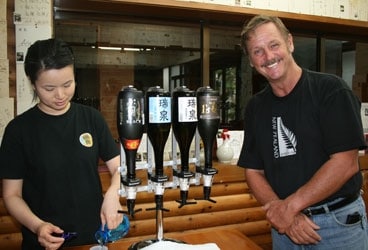
AlvahJapan368
Whenever I see Tere Batham’s byline on a CW article I dive right in because I find her style articulate and information accurate. Some time back she wrote about “Japan’s Guardian Winds,” explaining the difficulties in planning a passage to Japan from virtually any direction (“Outfoxing Japan’s Guardian Winds,” August 2002).
In spite of our conservative timing, or perhaps because of it, we found those winds, and lack thereof, still guarding the Land of the Rising Sun. We worked hard for 12 days through light airs until we were almost within sight of Okinawa. Then a real buster rolled down from the northwest. We hove to for 36 hours, read good books and consumed a fat mahi-mahi we had boated. When the winds abated we punched through to the southern city of Naha.
Here we found another type of wind guarding Japan–a wind created from the shuffle of paperwork that I thought might blow us back to Guam.
Upon arrival, the coast guard directed us to a tug basin and told us in halting English to wait for “our agent,” a Mr. Kinjo. Mega-yachts love these agent fellows because they act as translators and deftly navigate through a cumbersome entry process. But they don’t come cheap and our budget doesn’t accommodate such luxuries.
Mr. Kinjo arrived by boat. Seeing he was an agent, I expected he would speak English, but nary a recognizable word fell from his lips. I tried to explain that I did not require his services. Nevertheless, he began rapid firing information through cell phones in each hand.
Customs arrived, all three of them in shiny caps and epaulettes. I filled out a mountain of paperwork, in triplicate without carbons, listing our last 10 ports of call, exact dates of arrival and departure, all future ports of call with specific dates, and personal details sufficient to write a biography.
Then Quarantine arrived, and again the forms flew about the cabin like leaves in an autumn wind. The Coast Guard required the cubic equivalent of War and Peace in paperwork, then Mr. Kinjo huddled us into a car and raced us off to Immigration. Fingerprinted, photographed, and visas in hand, we then dropped copies of each bureaucracy’s papers to the others.
I go almost epileptic when faced with uniforms, stamps, and unnecessary layers of rules and regulations. Nevertheless, I kept smiling, bit my lip, and hummed, “We are sailing, we are sailing, across the waters, to be free.”
Japan has “Open” ports and “Closed” ports. The problem is no one could furnish us with a list of which are what. We entered at Naha because it is “Open,” but one cannot stay there. At Mr. Kinjo’s suggestion, in the morning we sailed for Ginowan Marina, five miles to the north. He met us by boat at the rain-swept entrance and guided us in.
There, lined up on the dock, each waiting their turn, was Customs, Animal Quarantine, et al. I groaned out-loud. One paper stated that the captain of any foreign-flagged vessel that enters a “Closed” port without prior written permission will be subject to 1 million-yen fine, two years imprisonment, and the confiscation of his boat. Then we were told that Ginowan was a “Closed” port. As the sweat broke on my brow I started to calculate just what 1 million yen meant in greenbacks.
Mr. Kinjo came to the rescue by rushing us to yet another office, Okinawa Development Marine Transport Agency, where we retroactively applied for permission to enter Ginowan.
I only mention this in such detail to describe my state of mind when we first broke through the rice-paper wall and got to actually see Japan. I went from wanting to head out for the open sea to being willing to endure this process on a weekly basis, all within four hours.
Mr. Kinjo, twin cell-phones blazing, took us on a whirlwind tour of Naha. In a bustling open market we puzzled over indistinguishable foods such as stacks of dried sea snake. In the traditional fabric section, a smiling clerk insisted on dressing Diana in the full kimono regalia. Diana swooned, delirious with delight, down the narrow lanes of the ancient pottery-making district. I felt a mild form of delirium myself after our tour of the Awamori (rice whiskey) distillery. (Hey, that’s part of the culture too.) And we both marveled at the elegant simplicity, yet grand scale of the ancient Shurijo Castle.
Simply put, already Japan appeared as astonishing, diverse, demanding, and rich with potential, and we had hardly been out of sight of the boat.
By the way, Mr. Maseo Kinjo is not an agent in the professional sense. He asks nothing for the indefatigable services he has rendered. He just loves sailing and likes sailors, and took it upon himself to help us get our feet planted upon this most amazing of lands.








